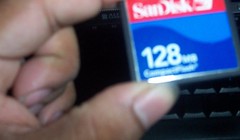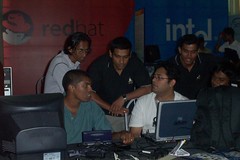Anyway today as I got to the Installfest De ja vu striked! A guy had brought a mini PDA to install GNU/Linux on to it. Now if you had watched Revolution OS, where coincidently most of us heard of the concept of an Installfest to in the first place, a similar guy comes hoping to install Linux on to tiny machine.
It seemed I was the chosen one to play the person who would have helped that person in the movie (except its never actually shown).
The PDA was an HP Jornada 680. After searching on the net, I came across its hardware specifications and a Linux distribution that was made to put on a Compact Flash (CF) disk. Lucky for me I had a 128MB CF card with me, which I recently bought for my digital camera that only came with 8MB ram.
Jornada 680/690 specifications:
CPU: 133MHz Hitachi SH3
RAM: 16MB(680) or 32MB (690)
Screen: Color, 640x240 pixels
Input: touch screen, laptop-like keyboard
Expansion slots: 1x type I CF and 1x type II PCMCIA
Expansion ports: serial (sync) port
Modem: Internal 56k (not on 680e/690e models)
View image
The steps on the site was quite straight forward except for two problems.
1. There didn't seem to be a CF card reader on the PDA but seemed to only have a PCMCIA slot.
2. I didn't seem to have a CF card reader.
After searching on the net, it didn't take long to discover the hidden CF slot under the PCMCIA slot which can be accessed through a door under the PDA.
After backing up my existing digital photos, I tried to mount the CF card when inside the camera as a normal USB device, but my model doesn't seem to emulate usb-storage. And then I remembered that I had my 30GB USB external hard drive/mp3 player that also had a CF card reader.
After getting that and plugging it to the notebook, I was able to format the CF disk and create 3 partitions using the fdisk utility. The first partition was a 8MB fat 32 which held the boot loader exe (shlo.exe) along with its config file slho.txt and a precompiled kernel for the SH architecture.

The second partition which was 100MB, was formatted to ext2, and the precompiled root file system was extracted to it. The third partition was formatted as a swap partition.
Once the CF card was installed to the PDA, it showed up in the WinCE explorer. Booting Linux was easy as double clicking the shlo.exe file. Initially it did hang the machine for about 45 seconds and then suddenly the display went all black for a beautiful tux logo on a framebuffer console display.


By this time, it was already 5'O clock and time to wrap up the installfest.